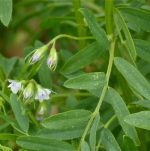 Lentil is a cool season annual domesticated in the Fertile Cresent and dating back to 7500-6500 BC. It is a member of the bean family, Fabaceae, that also includes means, lupines, and mimosa. The many branched plants grow 12-20″ tall may be erect or spreading. The slender stems are angular and hairy and leaves are pinnately compound with 5-8 pairs of oblong to elliptical leaflets that are yellowish green to bluish green. The leaves end with a tendril or bristle. In temperate climates the flowers appear from late spring to summer in the leaf axils on long slender stalks and may be white pink, purple, lavender or pale blue. The oblong pods are slightly inflated, about 5/8″ long, and usually contain 2-3 lens-shaped seeds. There are many different kinds of lentils and they differ in size, hairiness, and color of leaves, flowers, and seeds. The seeds are eaten cooked and are a staple in Indian cuisine. Lentil are nitrogen fixing plants and can improve the soil. The genus name, Lens, is the ancient Latin word meaning lentil plant. The specific epithet, colinaris, comes from the Latin word coquere, meaning to cook and refers to the use of the plant. The specific epithet, esculenta, comes from the Latin word edere and means to eat, and refers to the main use of the plant.
Lentil is a cool season annual domesticated in the Fertile Cresent and dating back to 7500-6500 BC. It is a member of the bean family, Fabaceae, that also includes means, lupines, and mimosa. The many branched plants grow 12-20″ tall may be erect or spreading. The slender stems are angular and hairy and leaves are pinnately compound with 5-8 pairs of oblong to elliptical leaflets that are yellowish green to bluish green. The leaves end with a tendril or bristle. In temperate climates the flowers appear from late spring to summer in the leaf axils on long slender stalks and may be white pink, purple, lavender or pale blue. The oblong pods are slightly inflated, about 5/8″ long, and usually contain 2-3 lens-shaped seeds. There are many different kinds of lentils and they differ in size, hairiness, and color of leaves, flowers, and seeds. The seeds are eaten cooked and are a staple in Indian cuisine. Lentil are nitrogen fixing plants and can improve the soil. The genus name, Lens, is the ancient Latin word meaning lentil plant. The specific epithet, colinaris, comes from the Latin word coquere, meaning to cook and refers to the use of the plant. The specific epithet, esculenta, comes from the Latin word edere and means to eat, and refers to the main use of the plant.
Type: Annual
Bloom: White pink, purple, lavender or pale blue flowers in leaf axils from late spring to mid summer, but varies greatly depending on the area where grown.
Size: 12-20″ H
Light:Full sun
Soil: Average, medium moist,well-drained; do not tolerate waterlogged or flooded soil
Hardiness: Zones 2-9
Care: Low maintenance
Pests and Diseases: Susceptible to many fungal and viral diseases and pests
Propagation: Seed
Companion Plants: Wheat, barley
Photo Credit: Wikipedia